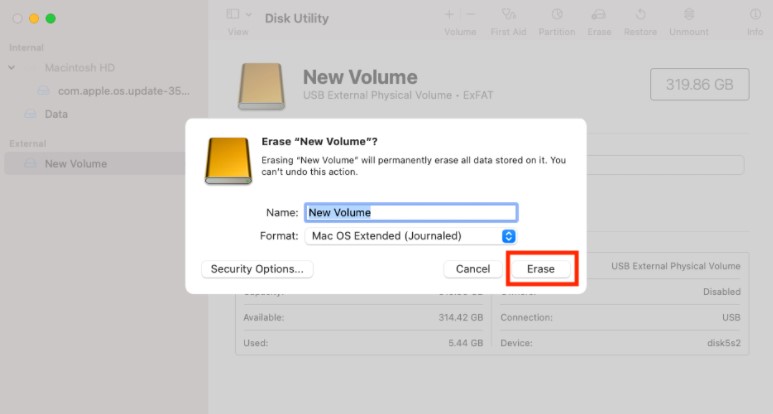

- #Mac os extended journaled max file size how to#
- #Mac os extended journaled max file size mac os#
- #Mac os extended journaled max file size full#
- #Mac os extended journaled max file size pro#
- #Mac os extended journaled max file size software#
Choose Edit > Delete APFS Volume from the menu bar, or click the delete volume button () in the Disk Utility toolbar. In theory, data capacity of up to 2 TB is possible, but Microsoft has limited the partition size in newer systems to 32 GB in order to promote the modern NFTS format.ĮxFAT is a further development of FAT that in principle offers unattainable storage and data capacity. From the sidebar in Disk Utility, select the volume that you want to delete. The maximum data size is limited to 4 GB in the latest version FAT32. You may also choose to encrypt external storage devices or individual files with your Mac. Encrypting your Mac will protect your files but will slow your Mac’s read/write speed. It is not supported by many applications.įAT is a file system developed by Microsoft that is also supported by Linux and macOS. What to Know Macs with a T2 security chip are encrypted by default, but will need to have password-protection for encryption enabled manually.
#Mac os extended journaled max file size mac os#
Mac OS Extended (Journaled) with the addition that the file system can differentiate between upper and lower case (e.g. HFS+ or Mac OS Extended (case-sensitive and journaled) Windows/Linux devices are only able to read but not write on USB sticks in this format. Has anyone else seen/tried other tools to fix broken files from the h.A file system developed by Apple that is particularly suited to data media with large memory capacity. It´s obviously possible (the Treasured tool for Macs can do it, at a cost of $159 per recovery.). Reformat the stick in Mac OS Extended (journaled) or Exfat. Making a recovery tool would be of great help, too. 1 reply Helpful Lexiepex Level 6 14,102 points 1:10 AM in response to tayloruae The stick is probably formatted as Fat or Fat32: the max file size is 4GB then. This file system doesnt have partition and file size limitations. Even better would be to use a file format that actually can be read, even if the writing process is interrupted for any reason. It allows you to format external drives that need to be used by both Macs and Windows PCs.
#Mac os extended journaled max file size how to#
Now, how to hande this is another matter - but "chunking" the recording (based on time andor file size) would at least help to make the problem a bit smaller. Not handling write()-errors is, to say the least, not good practice.
#Mac os extended journaled max file size software#
I haven´t tried the other scenarios, but the fact that the software didn´t in any way detect that the writes failed, tells me something about the quality of the software. In any of these scenarios, the file is broken, with no easy (or cheap.) way to fix it. or, as in my case, max file size reached other hardware/cable failure (eg loss of network drive, usb cable tripped over.)
#Mac os extended journaled max file size full#
file system full (very similar to "max file size reached", as seen from the program) But having software as fragile as Media Express i awfully bad design - a write can fail for many reasons: FAT32 (File Allocation Table) Read/Write FAT32 from both native Windows and native Mac OS X. True, I should have chosen to format the disk as something else than FAT32. Maximum file size: 16 EiB Maximum volume size: 64 ZiB You can use this format if it is supported by all computers with which you intend to share the drive.
#Mac os extended journaled max file size pro#
The technical quality of the h.264 pro recorder is great, but the software lets it down so badly I can´t recommend it to anyone at this point. I´d be happy to see some kind of tool to fix this - as it is, I´ve got two 4GB files of recordings that apparently can be fixed at a cost (running a zero budget production sort of makes this really unattractive), but so far I haven´t found any free(ish) tools that manage to do anything useful with the files. Most camcorders manage to do this perfectly well. When recording like this, the recording should be split at (e.g.) 2GB intervals. Mac OS Extended (Case Sensitive, Journaled) is HFS+ with a combination of case sensitivity and journaling. One thing is using a file format that is so sensitive to problems (i.e.: the recording process terminating abnormally for any reason, and not closing the file properly)Īnother thing is not handling maximum file size limits properly. It MIGHT be possible to save the files (using "Treasured" on a Mac, at a cost of $159.), but this is really, really bad design. as the file is "full", this cant happen).


(Technical: it´s missing its MOOV atom, as this should be written at the end of the file. Media express just continued to run - but when the file size reached 4GB, the file stopped growing, and the resulting file ended up corrupt. I backed up the Lion dmg file when I purchased it via the Mac App Store. I encountered something similar a couple of weeks ago - recording to a FAT32-formatted disk on a Mac. 62 A Mac machine needs to be reformatted with Lion.


 0 kommentar(er)
0 kommentar(er)
